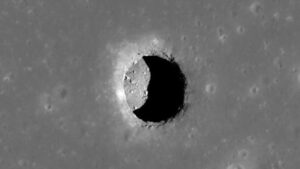A splinter-like object darting around deep space captured astronomers’ curiosity for two big reasons. One, it was the first object we’ve detected here that came from outside our solar system. Two, it kept changing speeds.
That prompted reflexive inquiry from skywatchers of all stripes, including a Harvard scientist working with the Pentagon: Was it an alien spacecraft?
A paper published Wednesday in the journal Nature replies, unequivocally, “no.” Instead, it’s a space rock that farts hydrogen every once in awhile as it tumbles through the varyingly hot and cold vacuum of space.
The object, called Oumuamua, drew attention on a recent junket past the sun. It accelerated as it escaped the sun’s gravity when it should have done the opposite. Comets sometimes exhibit similar behavior due to melting ice, but Oumuamua is not a comet.
No evidence of alien pilots
But instead of detecting evidence of alien pilots, the recent paper’s authors found that Oumuamua may have released, ahem, clouds of hydrogen molecules that had been trapped in ice below its surface as the sun warmed it. That had the effect of slowing it down on its way past the star. So it appeared to accelerate once the gassy discharges dissipated.
Oumuamua first appeared on the radar in October 2017. After a telescope in Hawaii spotted it, a free-for-all of data gathering and theorizing began. The object was traveling extremely fast, at 87.3 kilometers per second. It had no tail, despite showing comet-like properties. It was reddish-colored from “hundreds of millions of years” of absorbing cosmic radiation, and it was a weird shape.

This very deep combined image shows the interstellar asteroid Oumuamua at the center of the picture. It is surrounded by trails of faint stars that smeared as the telescopes tracked the moving asteroid. Photo: NASA/Karen Meech, ESO, et al
Cigar-shaped oddity
NASA found Oumuamua was approximately 400m long and about 10 times narrower than that. Observations suggested that Oumuamua “had been wandering through the Milky Way, unattached to any star system, for hundreds of millions of years” before its chance encounter with us.
Jennifer Bergner, a chemist at the University of California, Berkeley and the lead author of Wednesday’s study, said most recent research seeking to explain the object’s behavior revolved around its origins.
A number of studies tried to explain its variable speed and distant origins but none could do so without indulging in “improbable formation scenarios,” Bergner told Livescience.
Bergner’s paper postulated that once Oumuamua broke free of its home solar system, cosmic rays hit water trapped in its comet-like body, creating hydrogen. The researchers think that hydrogen usually remains trapped inside Oumuamua’s ice pockets.
The ice displays a structure similar to glass in the extreme cold of interstellar space. But near the sun, it started to crystallize. When that happened, the hydrogen found room to escape.

Artist’s impression of outgassing as a subtle cloud being ejected from the side of Oumuamua facing the Sun. Photo: ESA/Hubble, NASA, ESO, M. Kornmesser via Wiki Commons
Space farts
Karen Meech of the Institute for Astronomy at the University of Hawaii leads the team that first found Oumuamua. (Its name in Hawaiian means “a messenger from afar arriving first.”)
It’s likely that objects similar to Oumuamua hurtle around the solar system all the time. They’re just hard to detect. But plans to intercept one of these interstellar wanderers do exist, Meech told NPR.
If such a mission worked, we could find ourselves learning a lot more about distant star systems — partially, perhaps, through space farts.
There’s also the possibility that the aforementioned believer, Harvard astronomer Avi Loeb, was right. Maybe, Oumuamua is “a light sail of artificial origin” crafted by intelligent extraterrestrials, as Loeb and others suggested in a 2018 paper.
If you’re taking that road, keep your eye on the Pentagon’s All-domain Anomaly Resolution Office. (And take your chances on getting beamed up.)






